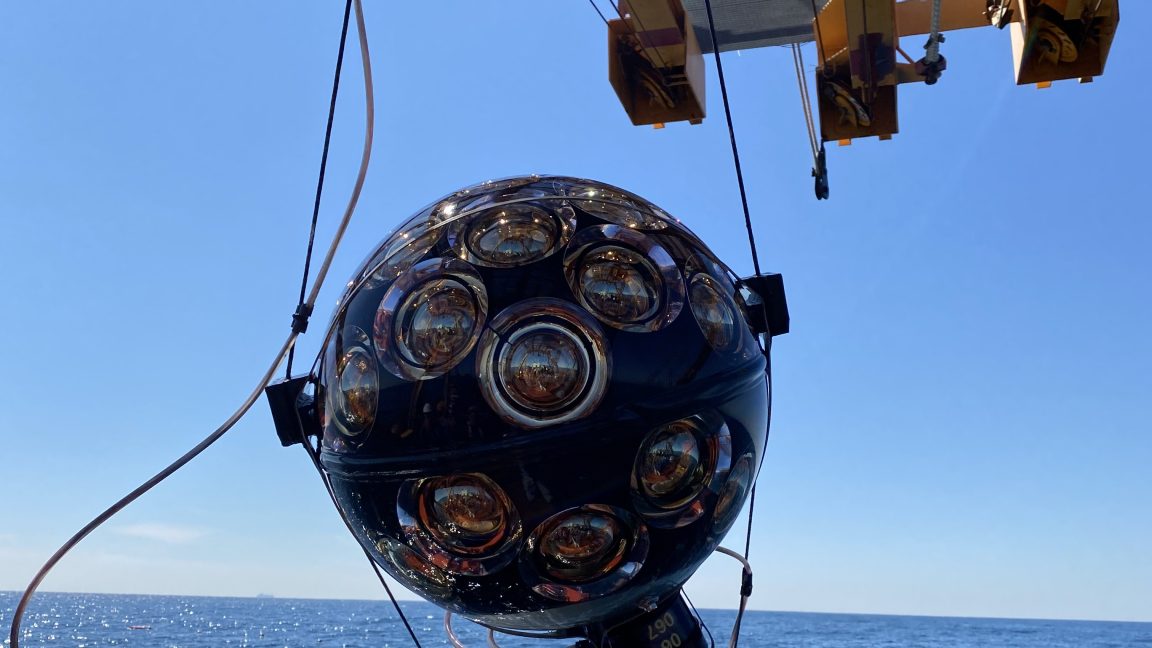
Seafloor detector picks up record neutrino while under construction
arstechnica.com
Tiny particle, big hit Seafloor detector picks up record neutrino while under construction Neutrino was over 10,000 times over the limits of our best particle accelerator. John Timmer Feb 12, 2025 12:25 pm | 21 Optical detection module of the KM3NeT neutrino detector. Credit: Patrick Dumas/CNRS Optical detection module of the KM3NeT neutrino detector. Credit: Patrick Dumas/CNRS Story textSizeSmallStandardLargeWidth *StandardWideLinksStandardOrange* Subscribers only Learn moreOn Wednesday, a team of researchers announced that they got extremely lucky. The team is building a detector on the floor of the Mediterranean Sea that can identify those rare occasions when a neutrino happens to interact with the seawater nearby. And while the detector was only 10 percent of the size it will be on completion, it managed to pick up the most energetic neutrino ever detected.For context, the most powerful particle accelerator on Earth, the Large Hadron Collider, accelerates protons to an energy of 7 Tera-electronVolts (TeV). The neutrino that was detected had an energy of at least 60 Peta-electronVolts, possibly hitting 230 PeV. That also blew away the previous records, which were in the neighborhood of 10 PeV.Attempts to trace back the neutrino to a source make it clear that it originated outside our galaxy, although there are a number of candidate sources in the more distant Universe.Searching for neutrinosNeutrinos, to the extent they're famous, are famous for not wanting to interact with anything. They interact with regular matter so rarely that it's estimated you'd need about a light-year of lead to completely block a bright source of them. Every one of us has tens of trillions of neutrinos passing through us every second, but fewer than five of them actually interact with the matter in our bodies in our entire lifetimes.The only reason we're able to detect them is that they're produced in prodigious amounts by nuclear reactions, like the fusion happening in the Sun or a nuclear power plant. We also stack the deck by making sure our detectors have a lot of matter available for the neutrinos to interact with.One of the more successful implementations of the "lots of matter" approach is the IceCube detector in Antarctica. It relies on the fact that neutrinos arriving from space will create lots of particles and light when they slam into the Antarctic ice. So a team drilled into the ice and placed strings of detectors to pick up the light, allowing the arrival of neutrinos to be reconstructed.The KM3Net project is built on the premise that Antarctica is extremely inconvenient. Instead, it's constructing two detectors on the floor of the Mediterranean: ARCA, about 3.5 kilometers down near Sicily, and ORCA, 2.5 kilometers deep and being built off the coast in France. Those are much easier to construct and link into the research infrastructure, but they sacrifice a bit of precision in reconstructing the track of a neutrino because the cables that hold the detectors drift around a bit in the currents.As of early 2023, only about 10 percent of the cables that will eventually hold detectors to the seabed were in place. But that was all that was needed to pick up an extreme event.Energy to spareThat event started somewhere outside the detector, where the incoming neutrino underwent an interaction that produced a muon, a heavier relative of the electron. The muon then entered the area covered by the detector and started bashing into things, producing photons and a few showers of particles, which then produced even more light. It was so energetic that the detectors nearest its arrival point were completely saturated; altogether, over a third of the individual detectors in the entire array picked up some indication of the muon's passage.Based on the timing of signals and the amount of energy released, the researchers were able to estimate the direction of origin of the muon, which suggests it traveled roughly parallel to the Earth's surface. Modeling the signals received by the detectors, the researchers estimate that the muon came in with an energy of between 60 and 230 PeV. Combined, these tell us that the muon had to be the product of a neutrino interacting with the ocean near the detector.No process that occurs on Earth can produce a muon with these sorts of energies. They can be produced when high-energy cosmic rays strike the atmosphere, but muons don't survive long enough to get from the atmosphere to the ocean floor along a flat trajectory like this one traveled along. And the only particle we know of that can survive to reach the ocean floor without interacting with something is a neutrino.Since the muon was a product of a neutrino interaction, the energy it carries must have been inherited from the neutrino itself. And that means the original neutrino likely had an even higher energy than the muon, meaning it's clearly the most energetic particle of its sort that we've ever detected.Howd that get here?What we don't have is a satisfying explanation for how it got all of that energy. One of the ideas is that high-energy gamma rays can convert energy to matter by interacting with the cosmic background radiation, imparting the newly created particles with a lot of energy in the process. A search of our galaxy in the direction of the neutrino's origin didn't reveal any gamma ray sources, though.Further out, there are a number of blazars, which are quasars that are oriented so that the jets of light and particles they produce point directly at Earth. Altogether, the research team identified about a dozen high-energy astronomical objects in the rough direction that the particle came from and two that reside within a one-percent deviation from the predicted path.So the event is probably telling us something about the cosmos, but we're not quite sure what yet.In the meantime, the construction of the two detectors is continuing. Once fully operational, they'll join IceCube in giving us data on neutrinos that originated outside our galaxy. If there are sources that regularly send high-energy neutrinos our way, having three detectors gathering data on them should give us a much better indication of where those sources reside. That means we should be able to simultaneously image the objects using both light and particles.Nature, 2025. DOI: 10.1038/s41586-024-08543-1 (About DOIs).John TimmerSenior Science EditorJohn TimmerSenior Science Editor John is Ars Technica's science editor. He has a Bachelor of Arts in Biochemistry from Columbia University, and a Ph.D. in Molecular and Cell Biology from the University of California, Berkeley. When physically separated from his keyboard, he tends to seek out a bicycle, or a scenic location for communing with his hiking boots. 21 Comments
0 Comments
·0 Shares
·17 Views








